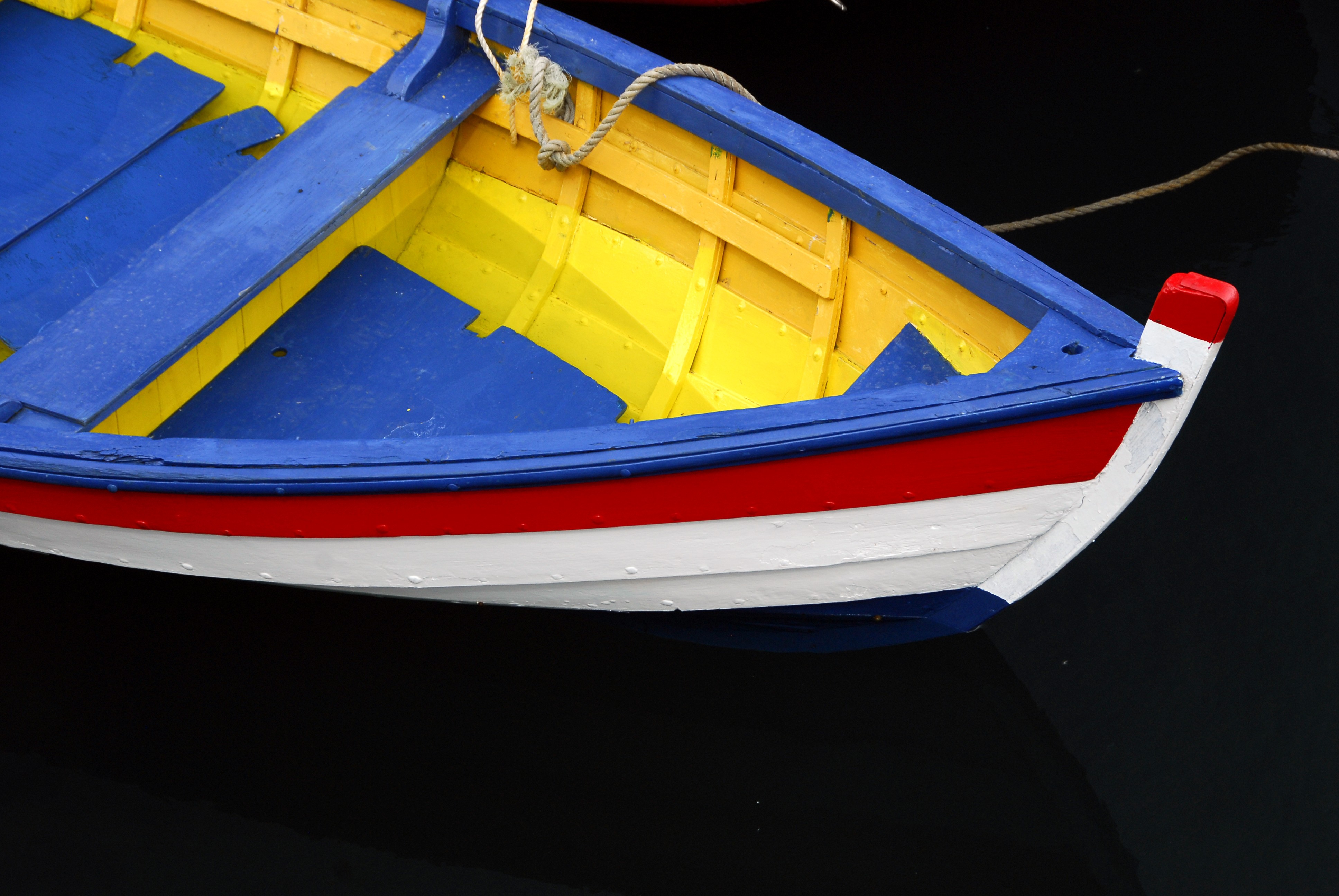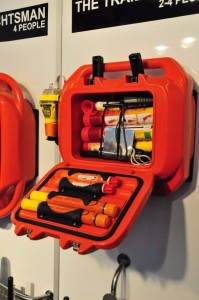Photo Essay
Life Cell, a Better Ditch Kit
Ditch bags are an invaluable accessory no blue water passagemaking vessel should be without. They are also nothing new; scores of bags are available from dozens of manufacturers, each offering its own twist on the concept of holding critical gear in the event of an emergency.
In December 2011 Scott Smiles, Rick Matthews and their two eleven year old sons found themselves floating and adrift after their boat sank with little warning six miles off the coast of Sydney, Australia. With scant seconds to grab essential safety equipment, they quickly found themselves clinging to an ice chest and little else while floating on Pacific swells. The story ended happily, the quartet was rescued by a Wespac Rescue Helicopter.
That event, however, inspired Scott and Rick to design a better mousetrap, a ditch bag that would, like an EPIRB or life raft, float free even if there was no time for retrieval. The product of that endeavor is the Life Cell, a ditch “module” that floats and whose contents are accessible by those in the water. Available in four sizes, the Crewman, Trawlerman, Yachtsman and Trailer Boat, these are designed to support 8, 6, 4 and 2-4 people respectively. Each Life Cell holds critical gear including EPIRB, flares, horn, whistle, flashlight and mirror, as well as providing room for wallet, keys, phone, sun block and a hand held VHF radio and water. The hard case, which is designed to float free from a sinking vessel (it does not utilize a hydrostatic release, although that may be something the manufacturer should consider) is equipped with a horizontal hatch that allows those in the water to, sea conditions permitting of course, to safely and easily access its contents. The Life Cell is also equipped with lanyards to enable those in the water to attach themselves to it, preventing survivors from drifting apart. The Life Cell comes with a 2 year warranty.
Contact Jenny Aiken, Business Development: jaiken@lifecellmarine.com.au; +0417 221 243; www.lifecellmarine.com.au
Ask Steve
Hi Steve,
[In reference to your eMagazine article on fuel additives] The elephant in the room concern I have about the “specified .520 scar” requirement of ULSD is that the requirement doesn’t meet most manufacturer’s fuel system lubricity specs. You just can’t sugar coat it in any other way.
ULSD’s lubricity spec is 2800 grams and .520; Deere’s spec is 3100 grams (more weight on the ball) and .450 scar (a smaller resulting scar), which, according to my math, seems to be a significantly more rigorous requirement. Deere’s spec encompasses fuel systems built by Bosch, Stanadyne, Lucas, Delphi, two vastly different versions of Denso HPCR and a few others.
I’ve attached a copy of the section covering lubricity in JD’s HPCR fuel systems (from CTM 220).
Courtesy of John Deere: Attachment 1, Attachment 2
Bob Senter
Bob:
Very good points, which I’m only to happy to share with readers, which reinforce the value of utilizing a lubricity additive such as Stanadyne Performance Formula. Thanks for the contribution.
__________
Steve:
I was on a delivery of a 55 ft. custom built catamaran recently. We were off Hatteras when heard a clunk-clunk on regular intervals, so we shut down the port side. 30 hours later we were finally able to inspect this at the dock in Hampton, VA. Turns out the cutlass bearing had literally screwed itself out of the shaft strut. There were only 2 small set screws, 180 degrees apart to retain this. Why wouldn’t there be snap rings in each end of the strut tube for axial retention?
Appreciate the insight.
Doug Dickinson
Doug:
Shaft bearing failures like this, while not common, are also not unheard of, they are often the result of improper installation and/or incorrect shaft alignment. Snap rings aren’t used, and I’m not sure they would have prevented this problem in that they may retain the bearing in the strut, however, they would not prevent it from spinning.
The set screws you mention typically do the job required of them provided they and the bearing are installed properly. My preference is to dimple (but not pierce) the outside of the bearing shell where the set screw engages it, increasing the engagement between the two, and set screws should be installed with a thread locking compound.
Bearings should not rely solely on these screws for support, the bearings are designed to be an interference fit, requiring some effort to press or push (but never hammer) them into a strut or shaft log. If the bearing shell’s fit is loose within the strut, set screws alone will not support them reliably. If the clearance between the bearing shell and the strut is too great, there is a problem, either the bearing has been incorrectly selected, or the strut has been machined improperly. In the latter case, waxing the bearing and “casting” it in place in thickened epoxy is one solution and an alternative to replacing the strut. Or, it may be possible to use a bearing with a larger shell diameter, turning it down or machining it to a smaller size.
Furthermore, if the shaft is not properly aligned with the bearing, it will place undue torque load on the bearing, inducing it to spin in the strut, or, in some cases, causing the rubber insert to spin within the shell. At the very least, improper shaft to bearing alignment will lead to excessive drag, bearing and shaft wear, as well as increased fuel consumption.
Before this bearing is simply replaced, the reason it separated from the strut should be determined.
__________
Steve,
I always enjoy reading your well-written and informative articles. In the Feb/March Professional BoatBuilder articles on bilge pump systems, you provided a very thorough discussion of 12-volt systems, but did not address the use of 110-volt A/C power.
During his pre-purchase survey of the boat, a well-known and highly regarded surveyor here in Annapolis advised me to install [as an adjunct to existing pumps] a high capacity 115-volt pump in my 42′ Grand Banks Motoryacht, the reason being that an 8kw genset can provide a significant margin of safety and reduce reliance on batteries. I’d be very interested in your opinion on this approach.
Thanks in advance.
Regards,
Robert Mullins
Bob:
The option of using 120 volts to power bilge pumps is a viable one under some circumstances, they are common aboard vessels over 65-feet. Several major bilge pump manufacturer offer 120 volt models, some of which come equipped with a standard receptacle type plug.
There is, however, the obvious risk of electrocution for such an installation, necessitating that the pump be wired with the benefit of a GFCI receptacle or circuit breaker. That alone would not be a reason to discard this concept, although if that GFI were to trip, the pump would obviously no longer operate. However, the logic behind using a 120 volt pump, as a preference over a DC model, aboard a small recreational vessel of this sort, is one I seriously question.
While battery power, and a charge source for it, the main engine’s alternator, is almost certainly always available aboard a vessel like yours, a 120 volt pump relies on a power source whose reliability is far from certain and for which there is no reserve, particularly in a flooding scenario. If the generator doesn’t start, and/or the inverter fails, the pump won’t work, period, however, if the main engine or generator are operational, a charge source for the batteries, and the batteries have substantial reserve capacity, and thereby a DC-powered pump, remains available, affording the DC option greater redundancy and flexibility. The range of AC-powered pumps is small, while scores of DC pump styles and sizes are available. Furthermore, while dockside, should shore power fail, the 120 volt pump becomes useless, while a DC pump would operate from the batteries for some time. Finally, there’s no difference in capacity between the two, DC pumps are available in the same size and capacity range of comparably sized AC pumps. Thus, I see no advantage, and several disadvantages, to the AC-pump approach.
__________
Steve,
How about an article about caulking on boats… how to remove, apply and which formulas don’t mildew or turn dark (ugly on a white boat). Our boat has some caulking on the deck around the windlass that looks like someone spread it with their thumb (on a seam 1/4″width).
I’m thinking of using one of those Dremel multi-max cordless oscillating scraper tools to remove the old calk.
Any tips would be great!
Norm Miller
Norm:
I have written about caulk in the past, as well as masking tape, however, it’s been a while, I suspect it’s time to revisit the subject. Look for this in an upcoming e-Magazine column.
The mildew issue is especially vexing and worthy of some discussion. I’ve had varying degrees of success with different brands, and location does play a part, Southern California, as you can imagine, isn’t much of an issue, while Florida is very challenging in keeping mold at bay.
While it’s considered taboo in the marine industry, I have had considerable success with using a silicone above the waterline caulk made by GE called Silpruf, it’s durable and resilient, and it hasn’t supported mildew in my experience. The issue with silicone is it will cause defects if paint or varnish are applied over it or even the smallest vestiges of it, causing what are known as ‘fish eyes’, which means you must be very careful during application, even residue on fingerprints is enough to cause a problem years later.
Traditionally, I’ve used the old fashioned pick approach toward removing caulk, it’s tedious to be sure. I haven’t used a Dremel tool to remove caulk, be careful of course not to go beyond the caulk footprint lest you scratch gelcoat or paint.
For making a pleasant-looking bead, I use a ball-type concrete shaping tool, kept lubricated with diluted soapy water. For visually critical areas, I will use masking tape as well.
Ask Steve questions should be addressed to asksteve@stevedmarineconsulting.com. Please include your full name and home port. Concise questions are more likely to be answered. For more information on the Ask Steve column, please visit www.stevedmarineconsulting.com/ask-steve/.
For more information on the services provided by Steve D’Antonio Marine Consulting, Inc. please e mail Steve at info@stevedmarineconsulting.com or call 804-776-0981.





